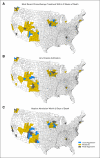Aggressiveness of cancer care near the end of life: is it a quality-of-care issue?
- PMID: 18688053
- PMCID: PMC2654813
- DOI: 10.1200/JCO.2007.15.8253
Aggressiveness of cancer care near the end of life: is it a quality-of-care issue?
Erratum in
- J Clin Oncol. 2010 Jul 1;28(19):3205
- J Clin Oncol. 2011 Nov 20;29(33):4472
Abstract
The purpose of this article is to review the literature and update analyses pertaining to the aggressiveness of cancer care near the end of life. Specifically, we will discuss trends and factors responsible for chemotherapy overuse very near death and underutilization of hospice services. Whether the concept of overly aggressive treatment represents a quality-of-care issue that is acceptable to all involved stakeholders is an open question.
Figures


References
-
- Rowland J, Mariotto A, Aziz N, et al: Cancer survivorship: United States, 1971-2001. MMWR 53:526-529, 2004 - PubMed
-
- National Cancer Policy Board: Ensuring Quality Cancer Care. Washington, DC, National Academy Press, 1999
-
- Earle CC, Park ER, Lai B, et al: Identifying potential indicators of the quality of end-of-life cancer care from administrative data. J Clin Oncol 21:1133-1138, 2003 - PubMed
-
- Earle CC, Neville BA, Landrum MB, et al: Evaluating claims-based indicators of the intensity of end-of-life cancer care. Int J Qual Health Care 17:505-509, 2005 - PubMed
-
- Earle CC, Neville BA, Landrum ME, et al: Trends in the aggressiveness of cancer care near the end of life. J Clin Oncol 22:315-321, 2004 - PubMed
Publication types
MeSH terms
Substances
Grants and funding
LinkOut - more resources
Full Text Sources

